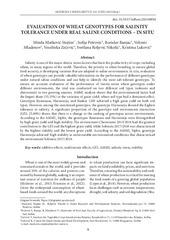Приказ основних података о документу
Evaluation of wheat genotypes for salinity tolerance under real saline conditions: In situ
Procena tolerantnosti genotipova pšenice na salinitet u realnim uslovima saliniteta – in situ
| dc.creator | Matković Stojšin, Mirela | |
| dc.creator | Petrović, Sofija | |
| dc.creator | Banjac, Borislav | |
| dc.creator | Mladenov, Velimir | |
| dc.creator | Zečević, Veselinka | |
| dc.creator | Roljević Nikolić, Svetlana | |
| dc.creator | Luković, Kristina | |
| dc.date.accessioned | 2023-08-02T09:13:36Z | |
| dc.date.available | 2023-08-02T09:13:36Z | |
| dc.date.issued | 2023 | |
| dc.identifier.issn | 0354-5881 | |
| dc.identifier.issn | 2406-209X - electronic | |
| dc.identifier.uri | http://RIVeC.institut-palanka.rs/handle/123456789/685 | |
| dc.description.abstract | Salinity is one of the major abiotic stress factors that limit the productivity of crops, including wheat, in many regions of the world. Therefore, the priority in wheat breeding, to ensure global food security, is developing varieties that are adapted to saline environments. In situ, evaluation of wheat genotypes can provide valuable information on the performance of different genotypes under natural saline conditions and can help to identify the most salt-tolerant genotypes. To ensure an accurate evaluation of the performance of twenty-seven wheat genotypes under different environments, the trial was conducted on two different soil types (solonetz and chernozem) in two growing seasons. AMMI analysis shows that the environmental factor had the largest share (55.15%) in the variation of grain yield, where soil type had a dominant effect. Genotypes Renesansa, Harmonija, and Bankut 1205 achieved a high grain yield on both soil types. However, among the mentioned genotypes, the genotype Harmonija showed the highest tolerance to salinity. A significant proportion of the genotype and environment interaction (GEI; 25.89%) shows that there is a change in the ranking of genotypes across environments. According to the AMMI1 biplot, the genotypes Renesansa and Harmonija were distinguished by high grain yield and high stability. The environment Chernozem 2015/2016 had the greatest contribution to the GEI and the highest grain yield, while Solonetz 2017/2018 was characterized by the highest stability and the lowest grain yield. According to the AMMI2 biplot, genotype Harmonija achieved high stability in unfavourable environmental conditions that characterized the environment Solonetz 2017/2018. | sr |
| dc.description.abstract | Zaslanjenost spada u najvažnije faktore abiotičkog stresa koji ograničavaju produktivnost useva, uključujući pšenicu, u mnogim regionima sveta. Stoga je razvoj sorti pšenice koje su prilagođene uslovima zaslanjenosti prioritet za globalnu sigurnost hrane. Procena genotipova u realnim uslovima – in situ može pružiti odgovarajuće informacije o performansama različitih genotipova u realnim uslovima i pomoći u identifikaciji tolerantnih genotipova na salinitet. Da bi se obezbedila tačna procena, dvadeset sedam genotipova pšenice ispitivano je u različitim agroekološkim sredinama. Ogled je zasnovan na dva različita tipa zemljišta (solonjec i černozem) tokom dve vegetacione sezone. AMMI analiza pokazuje da je faktor spoljašnje sredine imao najveće učešće (55,15%) u varijaciji prinosa zrna, gde je dominantan uticaj imao tip zemljišta. Genotipovi Renesansa, Harmonija i Bankut 1205, ostvarili su visok prinos zrna na oba tipa zemljišta. Među navedenim genotipovima najveću toleranciju na salinitet ispoljio je genotip Harmonija. Značajan udeo interakcije genotipa i sredine (GEI; 25,89%) u ukupnom variranju pokazuje da postoji promena u rangiranju genotipova u različitim sredinama. Prema AMMI1 biplotu, genotipovi Renesansa i Harmonija su se odlikovali visokim prinosom zrna i visokom stabilnošću. U agroekološkoj sredini Černozem 2015/2016, koja je imala najveći doprinos interakciji, postignut je najveći prinos zrna, dok je u agroekološkoj sredini Solonjec 2017/2018 ostvarena najveća stabilnost, ali i najniži prinos zrna. Prema AMMI2 biplotu, genotip Harmonija je postigao visoku stabilnost u nepovoljnim uslovima sredine Solonjec 2017/2018. | |
| dc.language.iso | en | sr |
| dc.publisher | Beograd : Društvo selekcionara i semenara Republike Srbije | sr |
| dc.relation | info:eu-repo/grantAgreement/MESTD/inst-2020/200054/RS// | sr |
| dc.relation | info:eu-repo/grantAgreement/MESTD/inst-2020/200117/RS// | sr |
| dc.relation | info:eu-repo/grantAgreement/MESTD/inst-2020/200216/RS// | sr |
| dc.rights | openAccess | sr |
| dc.rights.uri | https://creativecommons.org/licenses/by-nc-sa/4.0/ | |
| dc.source | Selekcija i semenarstvo | sr |
| dc.subject | additive effects | sr |
| dc.subject | multivariate effects | sr |
| dc.subject | GEI | sr |
| dc.subject | AMMI | sr |
| dc.subject | salinity stress | sr |
| dc.subject | stability | sr |
| dc.subject | aditivni efekti | |
| dc.subject | multivarijacioni efekti | |
| dc.subject | stabilnost | |
| dc.subject | stres saliniteta | |
| dc.title | Evaluation of wheat genotypes for salinity tolerance under real saline conditions: In situ | sr |
| dc.title | Procena tolerantnosti genotipova pšenice na salinitet u realnim uslovima saliniteta – in situ | |
| dc.type | article | sr |
| dc.rights.license | BY-NC-SA | sr |
| dc.citation.epage | 20 | |
| dc.citation.issue | 1 | |
| dc.citation.rank | M51 | |
| dc.citation.spage | 9 | |
| dc.citation.volume | 29 | |
| dc.identifier.doi | 10.5937/SelSem2301009M | |
| dc.identifier.fulltext | http://RIVeC.institut-palanka.rs/bitstream/id/2223/bitstream_2223.pdf | |
| dc.type.version | publishedVersion | sr |


